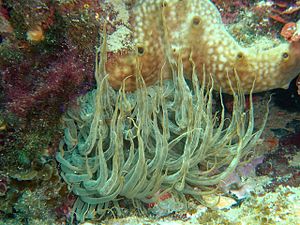Aiptasia
| Aiptasia | ||||||||||||
|---|---|---|---|---|---|---|---|---|---|---|---|---|

Aiptasia mutabilis , photo taken from the Mediterranean coast off Murcia . |
||||||||||||
| Systematics | ||||||||||||
|
||||||||||||
| Scientific name | ||||||||||||
| Aiptasia | ||||||||||||
| Gosse , 1858 |
Aiptasia is a genus of small, translucent sea anemones . Originally over ten species of sea anemones, which were mainly found in the tropics, belonged to the genus, but today it only has three species, Aiptasia couchii and Aiptasia mutabilis from the Mediterranean and the eastern, subtropical Atlantic, as well as the little-known tropical Aiptasia prima . The new genus Exaiptasia was established for Aiptasia pallida and for the eleven other species originally assigned to Aiptasia there is only an incomplete description that is no longer sufficient today. Most of the type specimens have also been lost in the meantime. In German, the sea anemones are also known as aiptasias or glass roses . The last name in particular is also used for some other sea anemone species, e.g. B. for Exaiptasia pallida .
features
Aiptasias have a wide, regularly shaped foot disk and a smooth, elongated body that is not clearly divided into the scapus (the lower longer cylinder that forms the stalk) and capitulum (head). The mouth disc is surrounded by up to 192 long and smooth tentacles. Six pairs of mesenteries (partition walls) divide the gastric space , with the number of distal and proximal mesenteries being the same or there are more distal mesenteries. The acontia, fine threads in the body cavity, are well developed. The cinclids, which are small openings in the body wall through which the acontia can be hurled outwards, are arranged in two to three rows. Spirocysts as well as microbasic B-mastigophores and P-mastigophores occur as nettle cells .
Aiptasias live in symbiosis with zooxanthellae of the genera Symbiodinium and Amphidinium ( Dinoflagellaten ) . They can reproduce asexually through longitudinal division .
literature
- Alejandro Grajales & Estefania Rodríguez: Morphological revision of the genus Aiptasia and the family Aiptasiidae (Cnidaria, Actiniaria, Metridioidea). Zootaxa 3826 (1): 055-100 doi: 10.11646 / zootaxa.3826.1.2